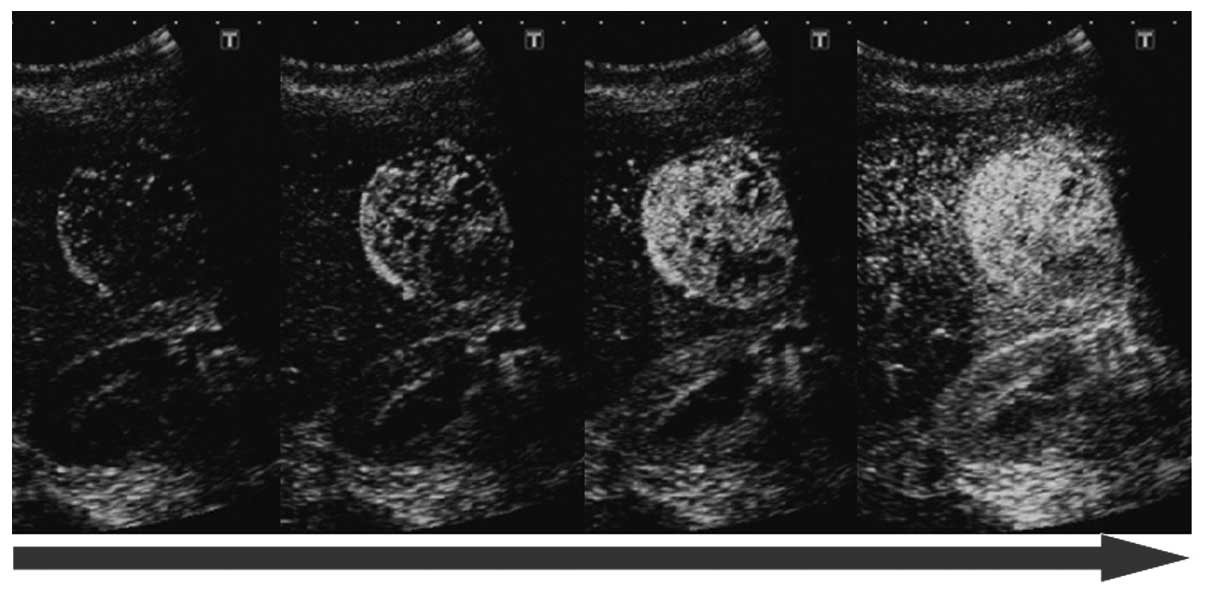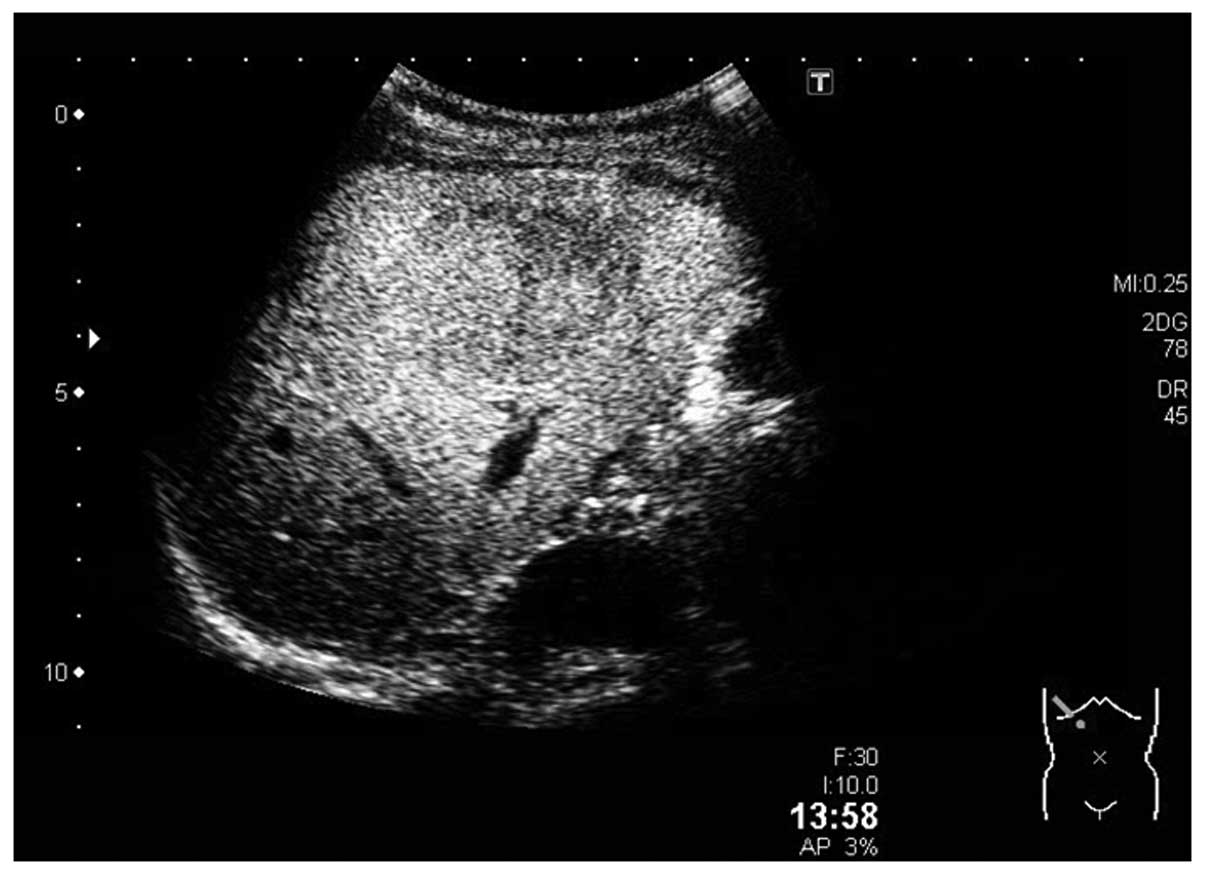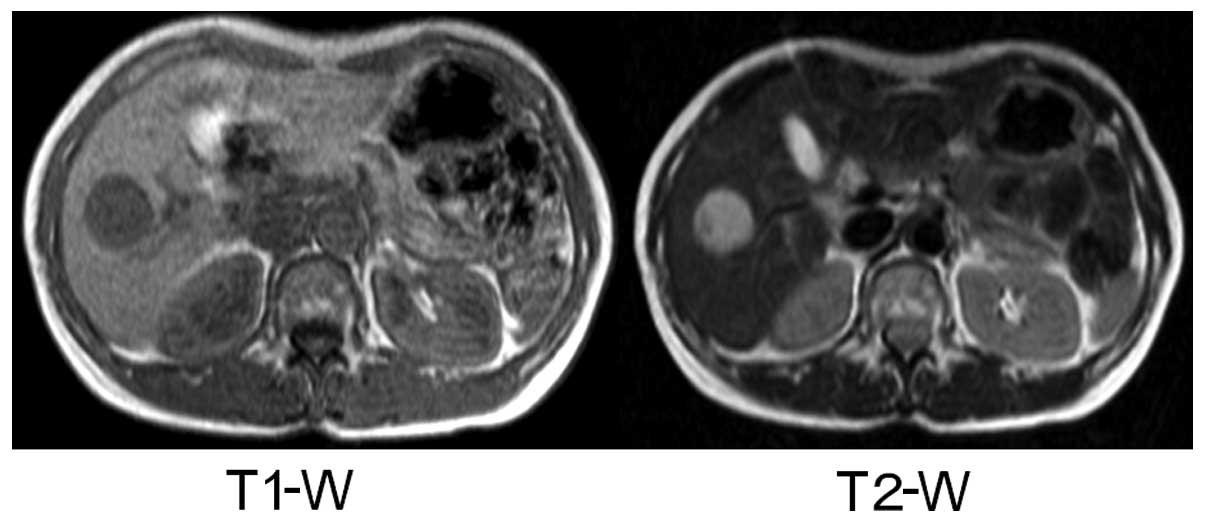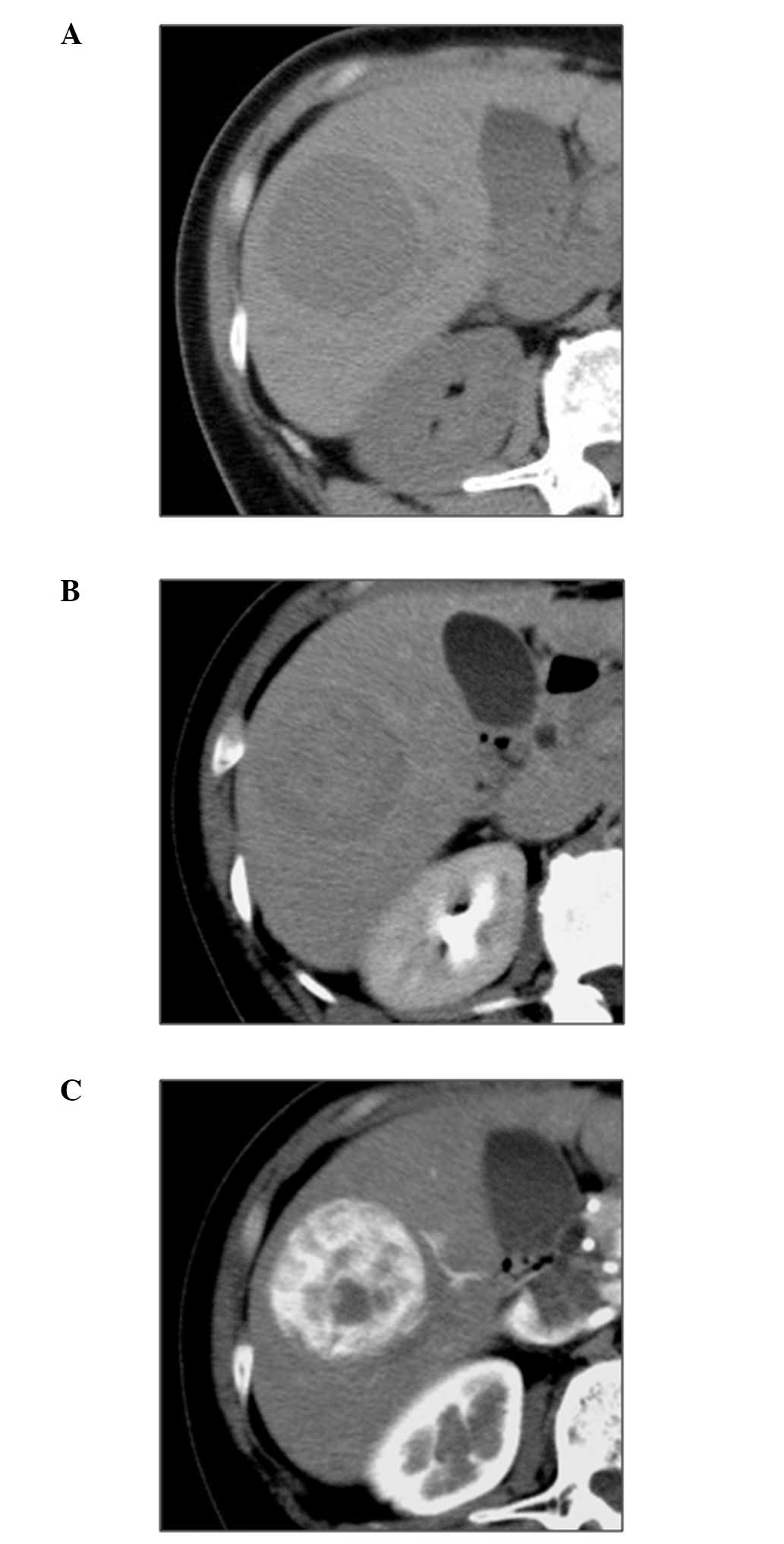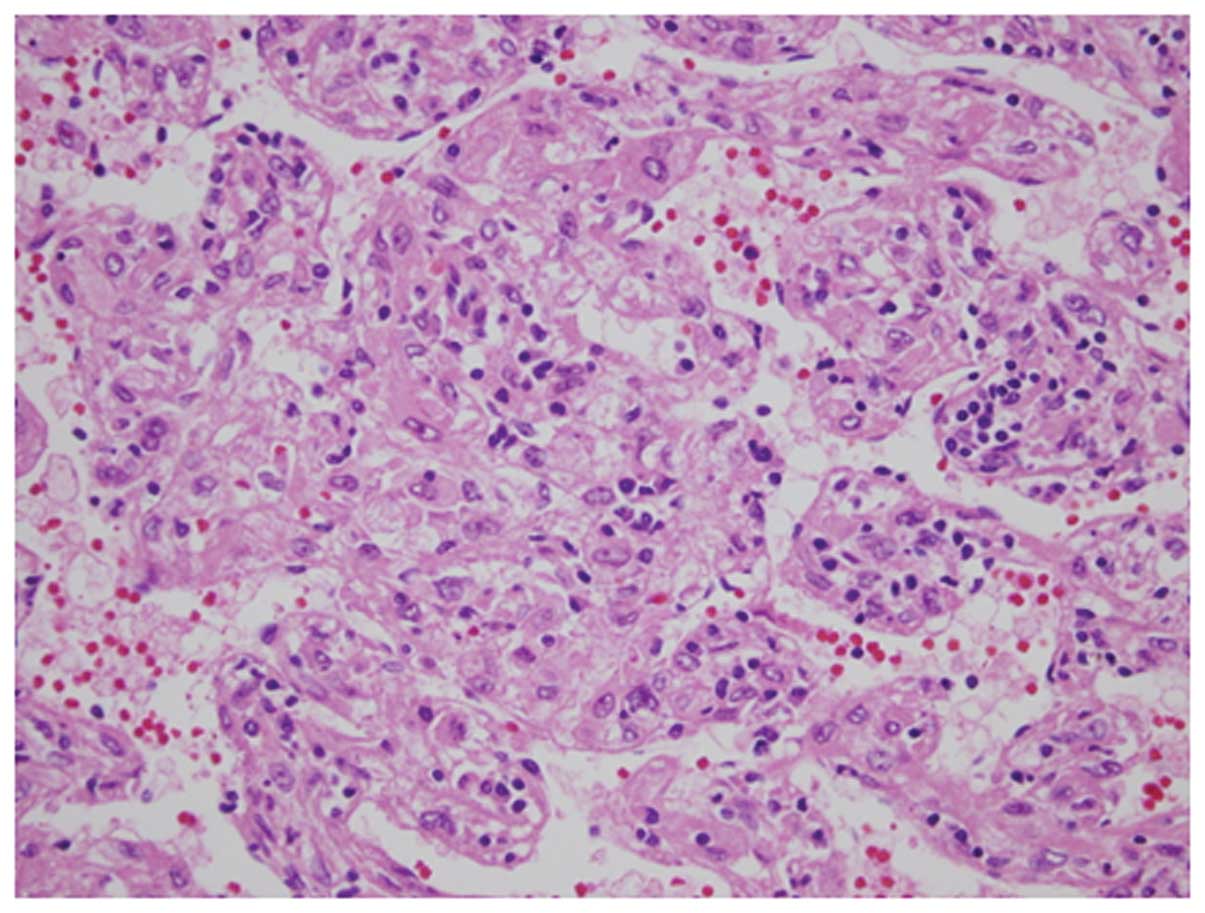A case of poorly differentiated hepatocellular carcinoma with intriguing ultrasonography findings
- Authors:
- Published online on: June 19, 2012 https://doi.org/10.3892/ol.2012.764
- Pages: 393-397
Abstract
Introduction
Similar to moderately differentiated hypervascular hepatocellular carcinoma (HCC), poorly differentiated HCC is generally rich in vasculature. Accordingly, these types of HCCs have often been classified together as ‘hypervascular HCC’ and as a consequence, ultrasonography (US) studies focusing exclusively on poorly differentiated HCC are rare. Here, we study a case of poorly differentiated HCC for which we conducted a detailed analysis of US images. The study was performed with the approval of the ethics committee at Toho University Omori Medical Center and with the consent of the patient.
Case report
A 60-year-old female patient was diagnosed as being a hepatitis B virus (HBV) carrier at approximately 30 years of age. Routine annual physical examinations since the initial diagnosis detected no abnormality until 2007 when US findings indicated the presence of a hepatic mass in the S5 region. The patient was referred to the Toho University Omori Medical Center (Tokyo, Japan) for a complete physical examination in November 2007. No subjective symptoms were observed. The patient had no history of alcohol drinking or smoking; however, the mother of the patient had succumbed to hepatic cirrhosis B. Additionally, with the exception of hospitalization due to a gastric ulcer at the age of 20 years, the patient had no previous history of major illness. Physical examination findings at presentation included height (151 cm), weight (45 kg), blood pressure (124/80 mmHg) and pulse rate (60 bpm). In addition, no anemia, jaundice, leg edema, palpable superficial lymph nodes, heart murmurs or pulmonary rales on auscultation were detected. The patient’s abdomen was soft and flat with no tenderness or splenomegaly, and neurological examinations revealed no abnormal findings.
Hematological findings revealed that the patient was positive for hepatitis B surface antigen (s) and e-antibody (e), but not for hepatitis C virus (HCV) antibody, and the HBV-DNA concentration was 5.2 LGE/ml. The levels of α-fetoprotein (AFP), protein induced by vitamin K absence or antagonist (PIVKA) II and carcinoembryonic antigen (CEA) tumor markers were all within the normal range (Table I). B-mode US revealed the presence of an oval-shaped mass (44×32 mm in diameter) in the S5 region of the liver. The mass had a hyperechoic rim-like high-echo band along the margin and an internal echo pattern, which was homogeneous and isoechoic to the surrounding hepatic tissue (Fig. 1). Contrast-enhanced US (CEUS) with Sonazoid demonstrated an early enhancement pattern extending from the outside to the inside of the mass in the vascular phase, and an enhancement pattern similar to that of the surrounding hepatic tissue in the post-vascular phase (Figs. 2 and 3). B-mode findings suggested that the lesion was a hemangioma, and due to the early enhancement pattern observed in the vascular phase of CEUS, the lesion was suspected to be a high-flow hemangioma. As the patient was a HBV carrier, we conducted magnetic resonance imaging (MRI) and computed tomography (CT) to eliminate the possibility of HCC. The mass was detected as low- and high-intensity signals on T1- and T2-weighted MRI images, respectively (Fig. 4). An abdominal CT scan revealed a low-density lesion in the plain phase, a heterogeneous high-density lesion in the early phase and a low-density lesion in the equilibrium phase (Fig. 5). Based on the collected results, the patient was diagnosed with hypervascular HCC and was subjected to laparoscopic right hepatic lobectomy.
Macroscopic findings revealed a brownish colour and an irregular surface of the liver (Fig. 6). No enlargement or atrophy was observed and the liver edge was reasonably sharp. Additionally, the tumor was a 40×28 mm grayish-white solid mass with a relatively clear margin and a capsule-like structure.
Histopathological findings identified solid tumor cells in the mass region (Figs. 7 and 8). Slit-like, or in certain parts, blood sinus-like spaces composed of endothelial cells were observed to be arranged in slightly ambiguous five-to-seven-layer cords. Tumor cells were not markedly eosinophilic and had an increased nuclear/cytoplasmic (N/C) ratio. Additionally, the cells had polymorphic and chromatin-rich nuclei. The mass was surrounded by a fibrous capsule, which was internally lined with a layer of lipid droplets as thick as the fibrous capsule, spreading along almost the entire circumference of the tumor. The pathological diagnosis was poorly differentiated HCC. The non-cancerous area was diagnosed as chronic hepatitis (F2/A1).
Discussion
Poorly differentiated HCC has a worse prognosis compared to well- and moderately differentiated HCC (1). Poorly differentiated HCC is also reported to have poor outcomes following living donor liver transplantation, which has increased in recent years (2). However, as poorly and moderately differentiated HCC have been grouped together as ‘hypervascular HCC’, the imaging characteristics of the former have rarely been studied in detail.
According to previous studies, hypervascular HCCs with a diameter greater than 15 mm observed using US are often associated with a hypoechoic halo (3), and a CEUS with Sonazoid signal that is weaker than that in the surrounding liver during the post-vascular phase (4). However, in the present case, we observed imaging features that are uncharacteristic of hypervascular HCC, including a hyperechoic (not hypoechoic) band around the mass on B-mode US, and the absence of perfusion defects on CEUS with Sonazoid images in the post-vascular phase.
Possible reasons for the atypical US finding of a hyperechoic band are that, from the histological standpoint, the tumor was not only enclosed by a fibrous outer capsule, but also covered by a layer of lipid droplets of a width similar to that of the capsule. This lipid droplet layer is suggested to be the hyperechoic rim observed on B-mode US. It is unclear why the tumor was covered with a layer of lipid droplets; however, it is possible that these droplets were pushed outwards in the late maturation phase as the biological malignancy of the tumor increased.
The absence of perfusion defects on CEUS with Sonazoid images in the post-vascular phase may have been caused by portal vein tumor thrombus in the vicinity of the tumor. The number of Kupffer cells reduces as the biological malignancy of HCC progresses (5–7). Furthermore, the post-vascular phase of Sonazoid-enhanced US imaging mainly reflects the number and functional role of the Kupffer cells in the liver, indicating that, in the case of hypervascular HCC, defects are present during the post-vascular phase of US (4). However, in the present case, the tumor did not appear as a defect, but as an isoechoic mass compared to the surrounding liver in that phase. A reason for this may be the presence of a portal vein tumor thrombus, which appears progressively as HCC develops (8). If a tumor thrombus is present in the portal vein, which serves as the exit for tumor blood flow, the contrast agent that enters the tumor will be prevented from exiting the tumor. This would force the contrast agent to remain in the tumor and not cause a perfusion defect. According to the 17th Annual Survey and Follow-up Study of Primary Liver Cancer conducted by the Liver Cancer Study Group of Japan, poorly differentiated HCC has a higher incidence of portal vein tumor thrombus compared to moderately differentiated HCC (9). The study also revealed that poorly differentiated HCC had fewer defects on post-vascular phase Sonazoid-enhanced US images compared to moderately differentiated HCC.
Poorly differentiated HCC has a worse prognosis than well- and moderately differentiated HCC. Clinically, it is extremely important to make a precise diagnosis of the disease using diagnostic imaging techniques, particularly non-invasive US. Here, we studied an notable case of poorly differentiated HCC which offers an insight into the relatively unknown imaging characteristics of poorly differentiated HCC.
Abbreviations:
|
US |
ultrasonography |
|
CEUS |
contrast-enhanced ultrasonography |
References
|
Nakajima Y, Shimamura T, Kamiyama T, Kimura J, Sato N, Matsushita M, Une Y and Uchino J: Evaluation of surgical resection for small hepatocellular carcinomas. Am J Surg. 171:360–363. 1996. View Article : Google Scholar : PubMed/NCBI | |
|
Jonas S, Bechstein WO, Steinmüller T, Herrmann M, Radke C, Berg T, Settmacher U and Neuhaus P: Vascular invasion and histopathologic grading determine outcome after liver transplantation for hepatocellular carcinoma in cirrhosis. Hepatology. 33:1080–1086. 2001. View Article : Google Scholar | |
|
Ohkuma K: Ultrasound diagnosis. Jpn J Cancer Clin. 47:987–994. 2001.(In Japanese). | |
|
Shunichi S, Hiroko I, Fuminori M and Waki H: Definition of contrast enhancement phases of the liver using a perfluoro-based microbubble agent, perflubutane microbubbles. Ultrasound Med Biol. 35:1819–1827. 2009. View Article : Google Scholar | |
|
Tobe K, Tsuchiya T and Fujiwara R: Kupffer cells in well-differentiated tissue of hepatocellular carcinoma. Acta Hepatol Jpn. 26:630–637. 1985.(In Japanese with English abstract). | |
|
Sugihara S, Nakashima O and Kiyomatsu K: Pathomorphologic study on macrophages in hepatocellular carcinoma. Acta Hepatol Jpn. 31:12–18. 1999.(In Japanese with English abstract). | |
|
Tanaka M, Nakashima O, Wada Y, Kage M and Kojiro M: Pathomorphological study of Kupffer cells in hepatocellular carcinoma and hyperplastic nodular lesions in the liver. Hepatology. 24:807–812. 1996. View Article : Google Scholar : PubMed/NCBI | |
|
Yabuuchi I, Matuda Y and Ifuji T: Classification of contrast enhanced US images of small hepatocellular carcinoma using Levovist. Kan Tan Sui. 47:175–182. 2003.(In Japanese with English abstract). | |
|
Ikai I, Arii S, Okazaki M, Okita K, Omata M, Kojiro M, Takayasu K, Nakanuma Y, Makuuchi M, Matsuyama Y, Monden M and Kudo M: Report of the 17th Nationwide Follow-up Survey of Primary Liver Cancer in Japan. Hepatol Res. 37:676–691. 2007. View Article : Google Scholar : PubMed/NCBI |




